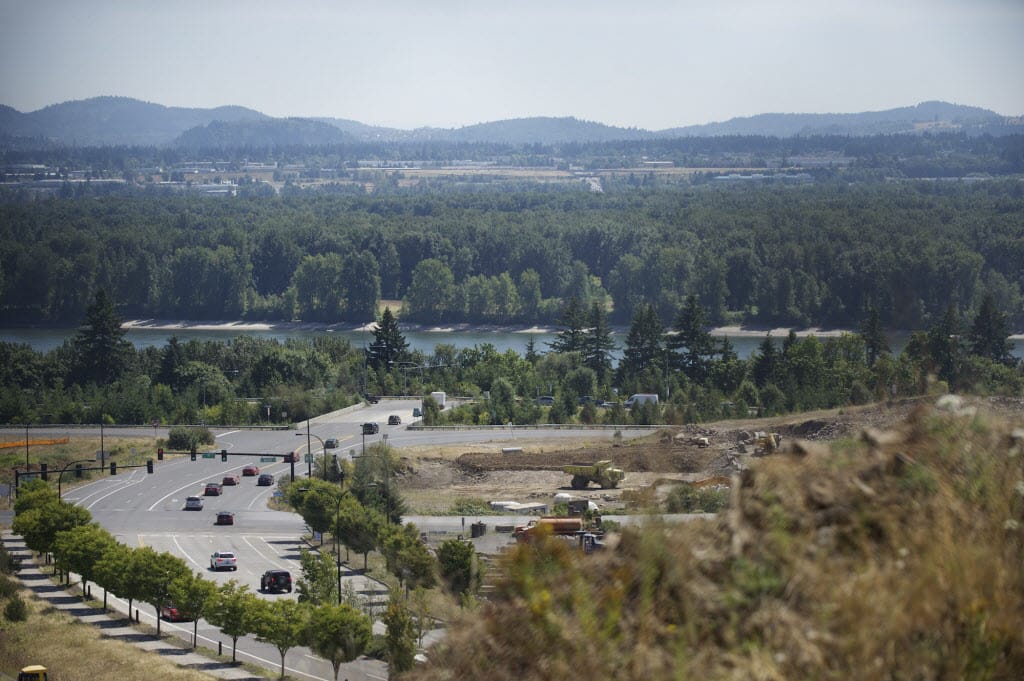A mixed-use development at Southeast 192nd Avenue just north of Highway 14 appears to illustrate another problem for Clark County Commissioner David Madore’s east county bridge proposal.
As with the other reasons why his plans aren’t likely to pencil out, however, Madore insisted it won’t be a problem.
An application for the 84-acre development, called Riverview Gateway, was submitted to the city of Vancouver on Aug. 6.
Consultant Don Hanson of Otak Inc., who submitted the application on behalf of the owner, Weston Investment Co. of Portland, said this week that if the Washington Department of Transportation thought it would be a good idea to build a bridge across the Columbia River at 192nd Avenue, the state wouldn’t have sold the property.
Ed Freeman, a Weston Investment partner charged with leading the Riverview Gateway project, said Tuesday that the company has spent seven years acquiring the necessary parcels from the state. WSDOT sold the former quarry to Weston in March 2006 for $17.6 million, then finalized a deal this year for a small additional piece of land north of the quarry for $1.5 million.
Freeman said he’d never heard of the idea for a bridge at 192nd Avenue until two weeks ago.
“We’re just going to proceed like it’s not happening,” Freeman said. “And I think that’s the correct assumption.”
As designed by Florida-based FIGG Engineering Group, Madore’s plan calls for a four-lane bridge to start at 192nd, extend over Government Island and end at Northeast Airport Way in Portland.
A second phase could extend the bridge to Interstate 84, said Linda Figg, the bridge company’s principal, during a presentation last month.
On Tuesday, Madore dismissed the notion that the preliminary application status signified the latest potential roadblock in moving ahead with an east county crossing, saying the bridge was “fully compatible” with the 84-acre project.
“(The bridge) doesn’t go into that area,” he said, referring to the Weston development.
He said he hadn’t talked to officials with Weston but planned to.
The Weston site, which is both east and west of 192nd Avenue and on both sides of Brady Road, contains 51.5 acres of land that can be developed. The development proposal calls for about one-quarter of the property to be developed as single-family residential housing and another quarter as retail space. About 20 percent would be multi-family residential, with 14 percent as office space and 8 percent as parks and open space.
Other potential problems
Madore has also waved off concerns that six of seven members of the Vancouver City Council (Mayor Tim Leavitt and Councilors Larry Smith, Jack Burkman, Anne McEnerny-Ogle, Alishia Topper and Bart Hansen) have said they don’t support the bridge and wouldn’t issue the necessary land-use and street-use permits. With the exception of Councilor Bill Turlay, the councilmembers say the city’s No. 1 bridge priority remains replacing the I-5 Bridge.
Vancouver City Attorney Bronson Potter said the county lacks authority to use eminent domain on a city street, so without city council approval, the bridge could not be built.
To that news, Madore, who initially mistakenly believed 192nd was within Camas city limits, has only said he hopes all interested parties can agree to work together.
An east county bridge isn’t in any regional long-range plans or maps, said Regional Transportation Council Executive Director Matt Ransom. Such a project would have to clear a number of regulatory hurdles.
Madore said in January the bridge would be completed in five years. He wants to wait to initiate formal reviews, however, until voters weigh in on November’s advisory vote, which asks whether they want the county to pursue the project.
During a July 25 presentation, Figg said the project would cost no more than $860 million and could be completed in five years. That timeline takes into account permitting and the design-build phase, she said. She also mentioned tolls as one way to pay for the project, but Madore later reiterated his promise to build a toll-free bridge. Madore has said Washington and Oregon will pay for it.
In addition to RTC, the project would also require approval of Metro, the Portland area’s regional government. It would also need approval from the Port of Portland, which owns Government Island. The port’s executive director, Bill Wyatt, has called the idea “a bridge from nowhere to nowhere.”
Dana Haynes, communications director for Portland Mayor Charlie Hales, said Hales hasn’t studied the proposal. However, he said Hales believes that urban planning should drive transportation funding, not the other way around.
According to a 2008 Transportation Corridor Visioning Study by the Southwest Washington Regional Transportation Council, the current population doesn’t support the need for a third bridge. The study concluded an east county bridge wouldn’t be necessary until the county’s population hits 1 million, or more than doubles.
Columbian Business Editor Gordon Oliver contributed to this story.



